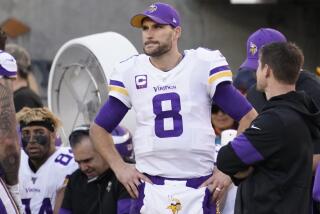NFL’s Free Agency Issue Just Keeps Coming Back
- Share via
The National Football League Players Assn. was born out of a desire for clean, dry uniforms in training camp.
In 1956, the Green Bay Packers, tired of putting on the sweat-soaked suits they had worn in the morning for their afternoon workouts, asked management for fresh uniforms for each two-a-day practice. When their request was denied, the Packers called for leaguewide solidarity on clean laundry.
Ten players met in New York that year and formed the NFLPA.
In 31 years, the players’ union has fought for--and won--many rights. Interestingly, free agency, the very right the union is most interested in wresting from the owners in the current strike, is one of them. The NFLPA was given that right 11 years ago but has bargained it away twice.
In 1971, the union voted to fight for free agency and challenged the so-called Rozelle Rule, which effectively tied a player to his team through a self-renewing option year on standard NFL contracts and gave NFL Commissioner Pete Rozelle the right to determine compensation for teams that might lose a free agent to another team. John Mackey, who played tight end for the Baltimore Colts and was president of the union, was the plaintiff in the suit, Mackey vs. NFL.
In 1974, while the case was still in federal court, the NFLPA struck during the exhibition season, its battle cry being, “No Freedom, No Football!”
After staying out for most of the six-game exhibition season, during which teams played with rookies and non-union free agents, the NFLPA ended its strike, returning to work without a contract.
Then, in late 1975, a Minneapolis court struck down the Rozelle Rule as a violation of federal antitrust laws, a decision that was subsequently upheld in several other cases. True free agency at last had come to football, although, because of appeals and continuing litigation, few players really got the benefit of it.
Then, in 1977, the NFL and the players’ union finally came to a collective bargaining agreement. One of its provisions specified that when a player became a free agent and signed with another team, the original team was entitled to compensation on a sliding scale, determined by how good a player the free agent was. Poof! There went true free agency.
By 1982, when the agreement expired, there had been virtually no movement of free agents, and the NFLPA struck again, although that year, the big issue was revenue sharing. Eventually, a five-year contract was signed, the free-agent compensation clause remaining intact.
During the five years of that contract, 1,415 players became free agents. Not one moved to another team under the compensation system. With that in mind, the union has renewed its demand for true free agency.
More to Read
Go beyond the scoreboard
Get the latest on L.A.'s teams in the daily Sports Report newsletter.
You may occasionally receive promotional content from the Los Angeles Times.











